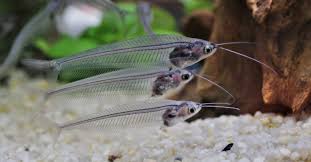1
/
of
1
Top Fin Aquatics
Glass Catfish
Glass Catfish
Regular price
$19.99
Regular price
Sale price
$19.99
Unit price
/
per
Tax included.
Shipping calculated at checkout.
Couldn't load pickup availability
Glass Catfish Care Guide
Glass Catfish (Kryptopterus vitreolus) are peaceful, transparent fish that bring a fascinating and delicate beauty to community aquariums. Their unique appearance and shoaling behavior make them a standout choice for well-maintained tanks.
Overview
- Scientific Name: Kryptopterus vitreolus
- Common Name: Glass Catfish (also sold as Ghost Catfish)
- Synonyms: None
- Distribution: Western Borneo, Indonesia
- Maximum Size: 7 cm (2.76")
- Temperature Range: 24–28°C (75–82°F)
- Water Parameters: pH 6.0–8.0, dH up to 20; adaptable to a wide range of conditions.
- Lighting: Low, with diffused light preferred.
- Compatibility: Peaceful community species.
- Sexual Dimorphism: Unknown.
Description & Habitat
Glass Catfish are an unusual and stunning species with a completely transparent body, making their internal organs and muscle structure visible. This oddball species thrives in groups of 6 or more and requires a well-planted aquarium to replicate its natural habitat:
- Natural Habitat: Slow-moving waters with dense vegetation in Western Borneo.
- Tank Setup: Provide both gentle and moderate water currents, as well as floating plants to diffuse light and create shaded areas.
- Social Behavior: Highly social and shy, Glass Catfish are best kept in shoals to reduce stress and encourage natural behavior.
Feeding
Glass Catfish can be finicky eaters but thrive on a diet rich in frozen and live foods:
- Staples: Small frozen foods such as mosquito larvae, daphnia, cyclops, and brine shrimp.
- Notes: They may be reluctant to eat dried foods. Avoid purchasing these fish if you cannot provide a steady supply of frozen or live food.
Breeding
Breeding Glass Catfish in home aquariums is rare, and detailed reports are not widely available:
- Reproductive Method: Egg scatterers.
- Conditions: It is believed they require soft water for spawning.
Share


